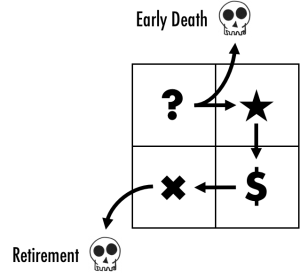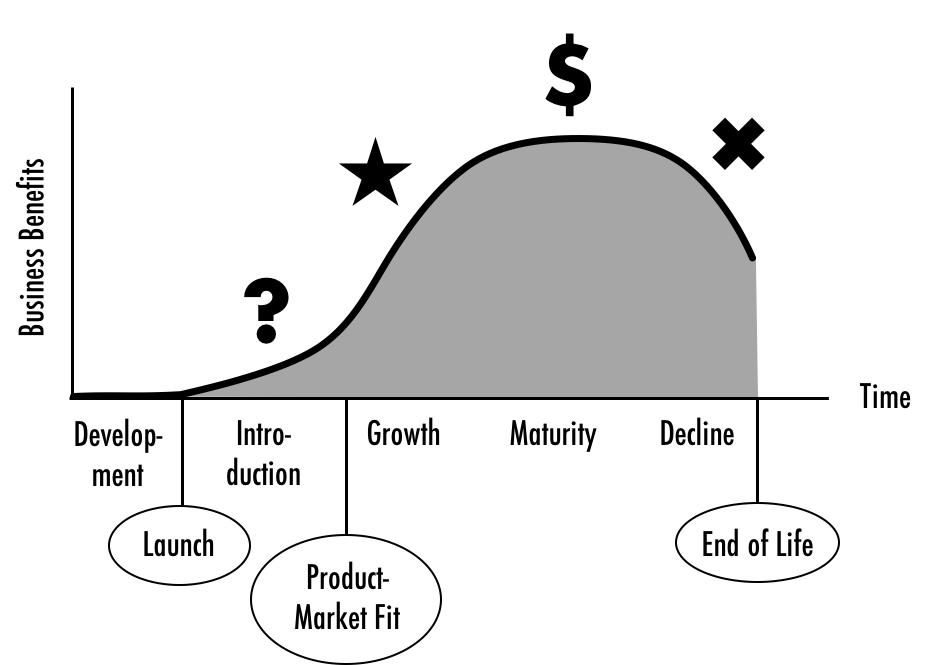Balance Your Portfolio with the Product Portfolio Matrix
The product portfolio matrix is a handy tool that helps you make the right product portfolio decisions. This post explains how you can effectively apply it to manage a portfolio of digital products.
The Matrix Reloaded
The product portfolio matrix, also called growth–share and BCG matrix, wants to help you achieve the right blend of young and established products in order to maximise the overall value the portfolio creates. The matrix categorises products as question marks, stars, cash cows, and pets (also known as dogs). The picture below shows the grid with its four quadrants and product types; cash cows are represented by the dollar sign and pets by a cross.
Question marks are products with high growth that don’t yet deliver significant business benefits—be it generating revenue, selling other products or services, enhancing the brand equity, or saving money. [1] Stars show high growth and deliver the desired benefits. Cash cows are products characterised by low growth, but they offer plenty of business benefits. Pets, finally, exhibit low growth and offer few benefits. A sample question mark might be Google Translate and Apple Watch, a star Microsoft Surface, a cash cow Google Search and Microsoft Windows, and a pet the iPod family.
When you apply the product portfolio matrix to the offerings in an established company, you’d like to see a healthy, balanced portfolio with enough question marks and stars that have the potential to become cash cows. You also need sufficient cash cows that generate the desired business benefits at a comparatively low cost and are therefore able to help fund the development of new products, question marks, and stars. Finally, you’d like to minimise the number of pets, as they incur cost but deliver only limited benefits.
From Question Mark to Cash Cow
The quadrants of the portfolio matrix form an interesting relationship: Products start out as question marks. If they are to become successful, they have to develop into stars and then morph into cash cows. Both development steps require effort, time, and money. You may have to change or enhance the features, user experience, and architecture of the product; you may have to adjust the business model and opt for different marketing and sales strategies; and some products require a pivot—think of Youtube, which started out as a dating website, and Flickr, which was an online game before it became a photo-sharing website.
Once a product has become a star or cash cow, it is able to offer the desired business benefits. While stars still require substantial investment to sustain the growth, for example, more or improved features, cash cows need less money but still provide significant benefits, as features are largely incrementally enhanced. A revenue-generating product is now most profitable (hence the term cash cow).
Eventually, though, cash cows will lose their ability to provide business benefits and become pets. These products provide few benefits but still consume money to maintain them. The following picture shows the desired development sequence from question mark to pet.
As every successful product will become a pet and eventually die, it is crucial that you are able to replace ageing cash cows with stars and stars with question marks. At the same token, you must invest enough in new product development initiatives to generate new question marks—assuming that you want to grow organically.
Your product portfolio therefore requires regular adjustments, and portfolio management should be a common activity. As a rule of thumb, review your product portfolio once per quarter and initiate the necessary changes.
Product Portfolio Matrix and Product Life Cycle
As you may have noticed, the development sequence discussed above is correlated with the product life cycle: Question marks tend to be products in the introduction stage; stars are products in growth; cash cows are mature offerings; and pets are products in decline. The picture below illustrates this relationship.
Note that the picture above does not account for life cycle extensions—prolonging the life expectancy of a product by adding new features, optimising existing ones, creating variants, or taking it to a new market or market segment, for instance. Such a measure extends the product’s status as a star and prevents it from prematurely becoming a cash cow.
Avoiding Common Mistakes
In theory, the development from question mark to pet and retirement should be straight forward and result in a healthy portfolio. But in practice, I see companies make three common portfolio management mistakes: focussing too much on stars and cash cows, not retiring pets, and clinging on to unsuccessful question marks.
Too Much Focus on Stars and Cash Cows
The first mistake is focussing too much on cash cows and stars and neglecting question marks and new product development initiatives, something particularly bigger companies are prone to in my experience. This is due to their tendency to optimise structures and processes for managing existing, successful assets, which makes it hard to deal with the amount of innovation and risk present in new and young products. But focusing too much on stars and cash cows leads to an unbalanced, ageing portfolio, as shown in the picture below.
 To prevent such a portfolio, invest 25% of your budget in brand-new products and question marks, and ensure that the teams have the right environment to quickly experiment, fail, and learn. [2]
To prevent such a portfolio, invest 25% of your budget in brand-new products and question marks, and ensure that the teams have the right environment to quickly experiment, fail, and learn. [2]
Keeping Pets for too Long
The second mistake is clinging on to pets to secure influence through a large portfolio even if their benefits are rapidly declining. You should, of course, do the opposite: retire products that are no longer sufficiently beneficial. Take the iPod Classic, Apple’s original and iconic MP3 player. The product was rightly discontinued in 2014 after it had experienced a continued decline in sales.
Clinging to Question Marks
The third mistake, finally, is to over-invest in question marks and to hold on to them for too long: Not every question marks will become a star. Some just die prematurely. Take, for example, Google Wave, a product that combined e-mail, instant messaging, and wikis. Wave was discontinued about a year after its launch in 2009. It never experienced stardom and died as a question mark.
The following picture shows that retirement is not the only exit point in the portfolio matrix but that products may have to be discontinued as question marks.

To avoid over-investing in your question marks, ensure that all products in your portfolio have clear business goals and use the right KPIs to track product performance. If the latter stays flattish even though you have made significant changes to your product, then pivot or discontinue it early like Google did with Wave.
Notes
[1] I have tweaked the original product portfolio matrix by using business benefits instead of market share on the horizontal axis. When Bruce D. Henderson developed the matrix in 1970, he focused on revenue-generating products; digital products, as we know them today, did not exist. But many digital offerings do not directly generate revenue—take, for example, Amazon Kindle and Google Chrome. Instead, they provide different types of benefits to their companies, such as, help sell another product or service (Kindle books), collect data to learn more about user behaviour and build new products (Chrome), and tie the user into the company’s ecosystem (both products). Substituting market share with benefits makes the product portfolio matrix applicable to all digital products.
[2] Bansi Nangji and Geoff Tuff recommend in their article “Managing Your Innovation Portfolio” that companies should invest about 10% in disruptive or transformational initiatives and about 20% in incremental or adjacent ones. As a life cycle extension counts as an adjacent innovation, 25% makes a good rule of thumb for new development initiatives and question marks in my opinion.
| Reference: | Balance Your Portfolio with the Product Portfolio Matrix from our JCG partner Roman Pichler at the Pichler’s blog blog. |






